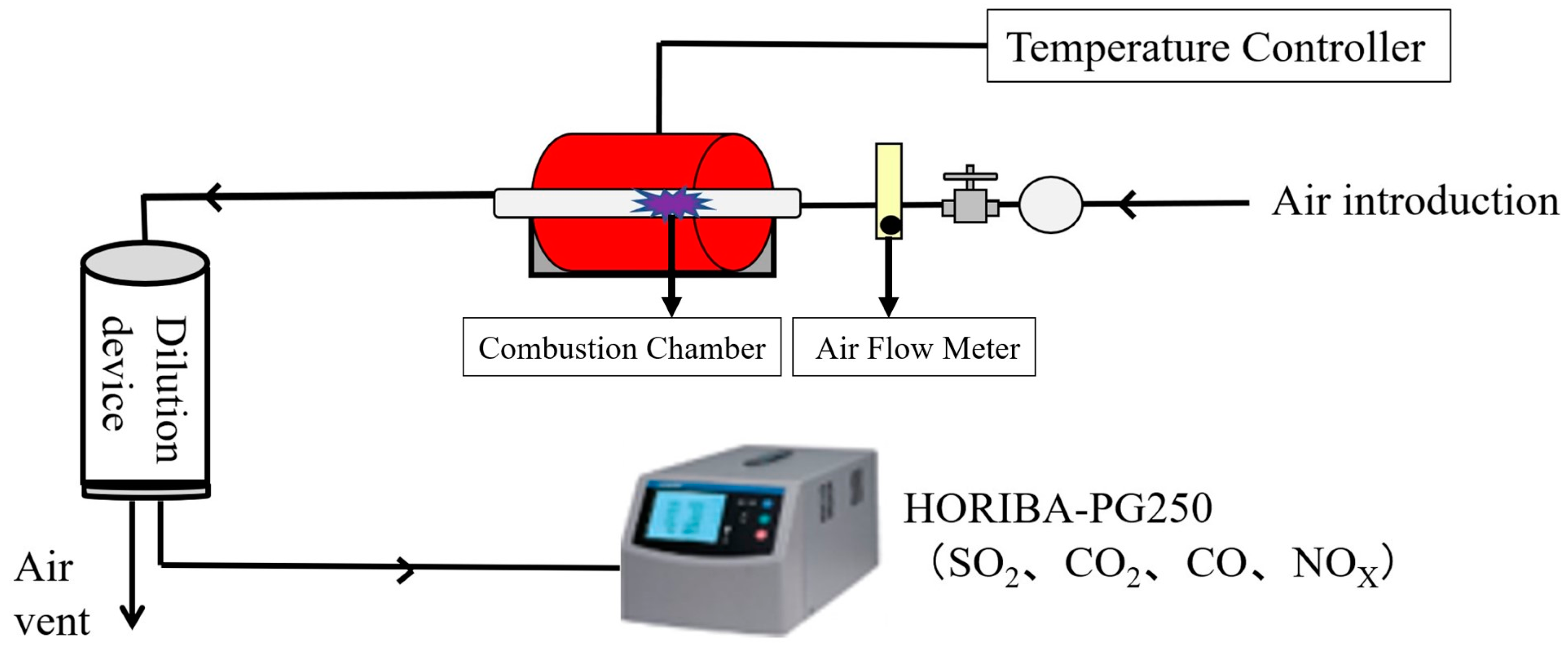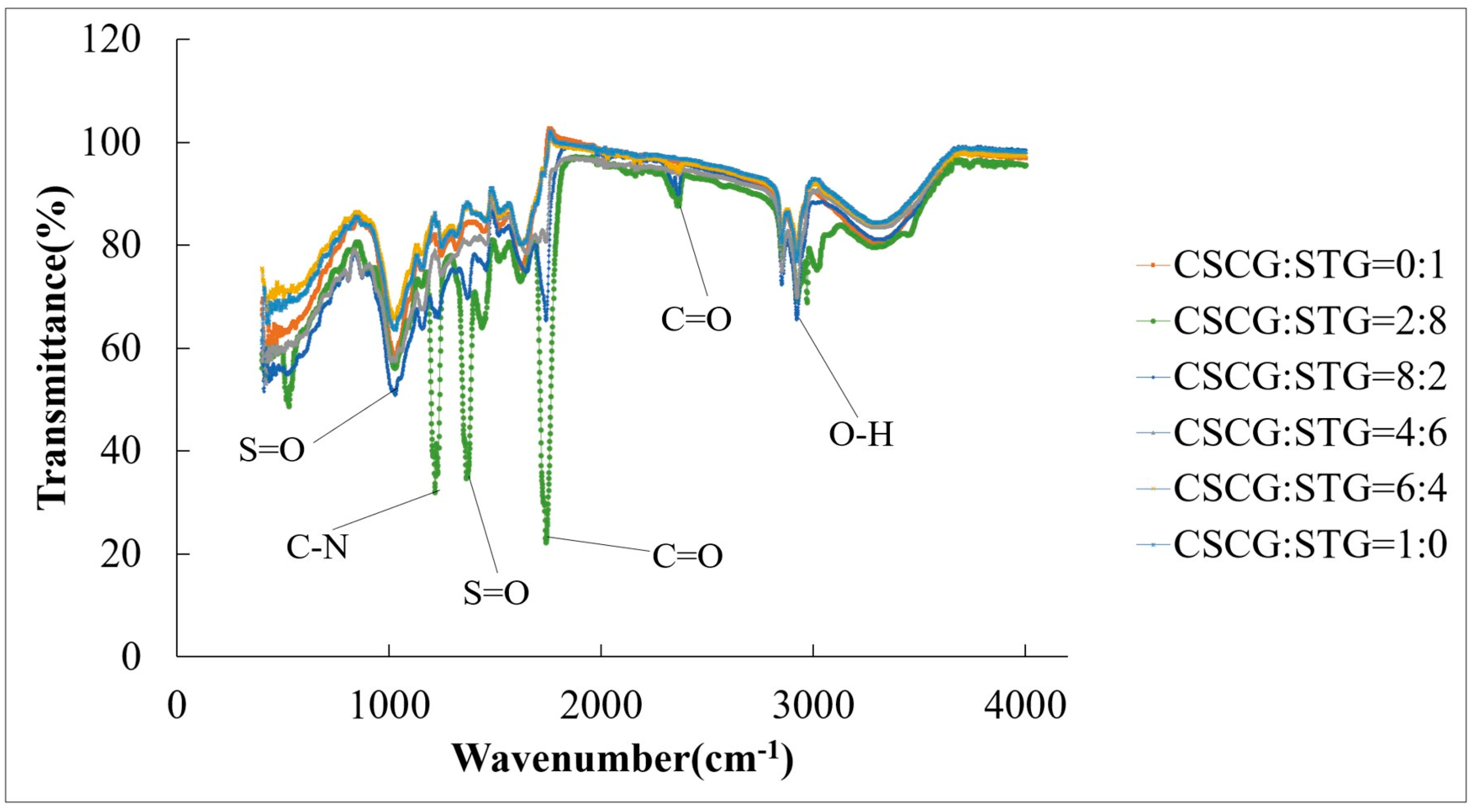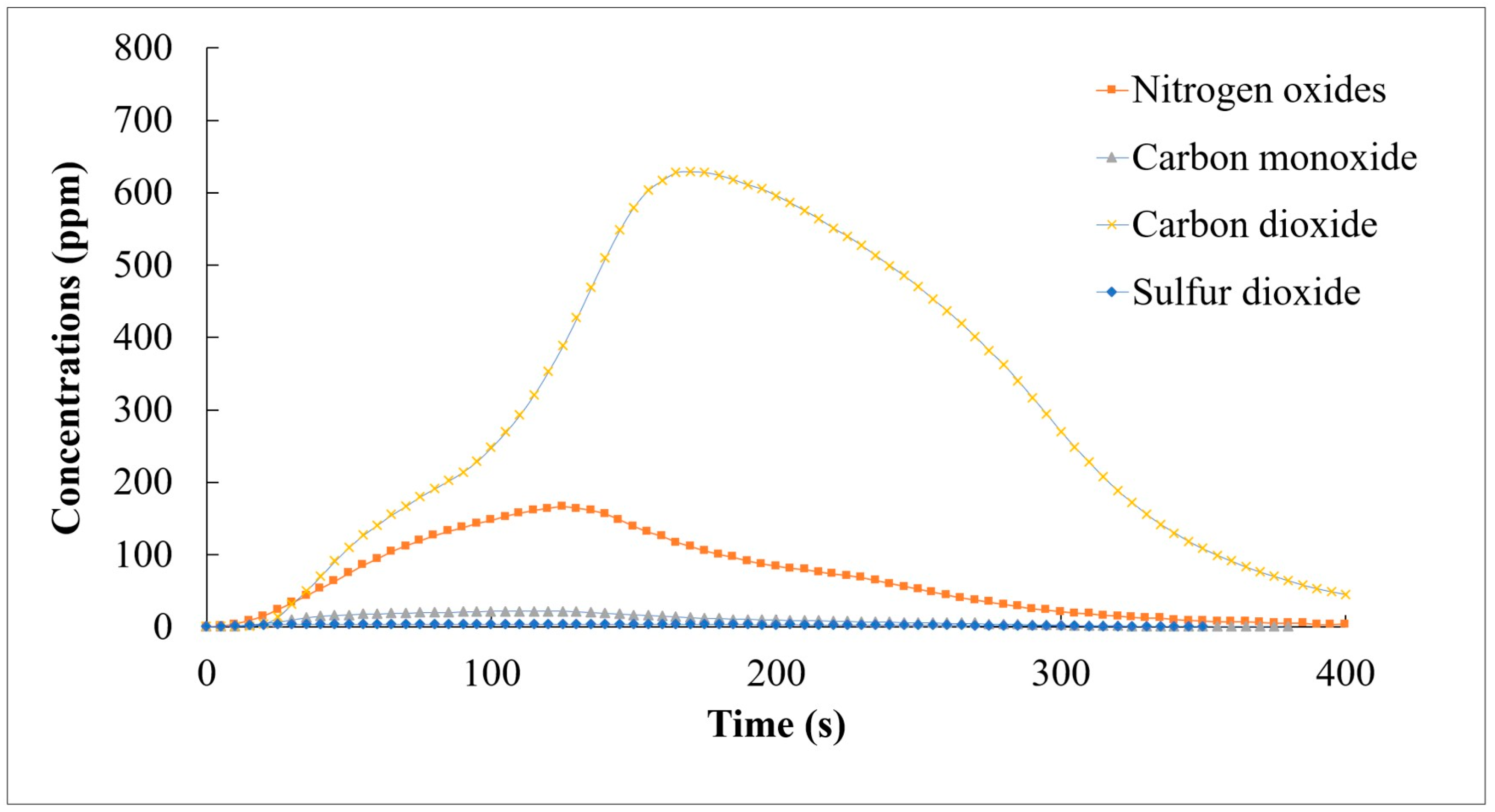Characterization of Waste Biomass Fuel Prepared from Coffee and Tea Production: Its Properties, Combustion, and Emissions
Abstract
:1. Introduction
2. Materials and Methods
2.1. Collection of Spent Coffee Grounds and Spent Tea Grounds
2.2. Pelleting Process for Spent Coffee and Tea Grounds
2.3. Analyzing the Properties of the Waste Biomass Mixture
2.4. Assessment of Calorific Value
2.5. Analysis of Surface Functional Groups
2.6. Test Setup and Equipment
3. Results and Discussion
3.1. Chemical Properties of Spent Coffee and Tea Grounds
3.1.1. Proximate and Ultimate Analyses of Spent Coffee and Tea Grounds
3.1.2. Calculation of the Calorific Value
3.1.3. Biomass Composition of Spent Coffee and Tea Grounds
3.1.4. Metal Contents of Spent Coffee and Tea Grounds
3.1.5. Functional Group Analysis of SCG and STG Pellet Fuels
3.2. Physical Properties of SCG and STG Pellet Fuels
3.2.1. SEM Analysis of SCG and STG Pellet Fuels
3.2.2. Physical Characterization of SCG and STG Pellet Fuels
3.3. Results of the Combustion Test
3.4. Concentrations of Different Gasses from the Emissions
3.5. Comparing Emissions with Traditional Coal Fuels
3.6. Comparing the Results with Traditional Coal Fuels
4. Conclusions
Author Contributions
Funding
Institutional Review Board Statement
Informed Consent Statement
Data Availability Statement
Conflicts of Interest
References
- Shahzad, U. The Need For Renewable Energy Sources. ITEE J. 2017, 2, 16–18. [Google Scholar]
- Pokrajac, L.; Abbas, A.; Chrzanowski, W.; Dias, G.M.; Eggleton, B.J.; Maguire, S.; Maine, E.; Malloy, T.; Nathwani, J.; Nazar, L.; et al. Nanotechnology for a Sustainable Future: Addressing Global Challenges with the International Network4Sustainable Nanotechnology. ACS Nano 2021, 15, 18608–18623. [Google Scholar] [CrossRef] [PubMed]
- Debnath, B.; Haldar, D.; Purkait, M.K. Potential and Sustainable Utilization of Tea Waste: A Review on Present Status and Future Trends. J. Environ. Chem. Eng. 2021, 9, 106179. [Google Scholar] [CrossRef]
- Sermyagina, E.; Mendoza Martinez, C.L.; Nikku, M.; Vakkilainen, E. Spent Coffee Grounds and Tea Leaf Residues: Characterization, Evaluation of Thermal Reactivity and Recovery of High-Value Compounds. Biomass Bioenergy 2021, 150, 106141. [Google Scholar] [CrossRef]
- Agrawal, D.; Gopaliya, D.; Willoughby, N.; Khare, S.K.; Kumar, V. Recycling Potential of Brewer’s Spent Grains for Circular Biorefineries. Curr. Opin. Green Sustain. Chem. 2023, 40, 100748. [Google Scholar] [CrossRef]
- Rajesh Banu, J.; Kavitha, S.; Yukesh Kannah, R.; Dinesh Kumar, M.; Preethi; Atabani, A.E.; Kumar, G. Biorefinery of Spent Coffee Grounds Waste: Viable Pathway towards Circular Bioeconomy. Bioresour. Technol. 2020, 302, 122821. [Google Scholar] [CrossRef]
- Kalair, A.R.; Seyedmahmoudian, M.; Stojcevski, A.; Abas, N.; Khan, N. Waste to Energy Conversion for a Sustainable Future. Heliyon 2021, 7, e08155. [Google Scholar] [CrossRef]
- Tymoszuk, M.; Mroczek, K.; Kalisz, S.; Kubiczek, H. An Investigation of Biomass Grindability. Energy 2019, 183, 116–126. [Google Scholar] [CrossRef]
- Ibitoye, S.E.; Mahamood, R.M.; Jen, T.C.; Loha, C.; Akinlabi, E.T. An Overview of Biomass Solid Fuels: Biomass Sources, Processing Methods, and Morphological and Microstructural Properties. J. Bioresour. Bioprod. 2023, 8, 333–360. [Google Scholar] [CrossRef]
- Roni, M.S.; Chowdhury, S.; Mamun, S.; Marufuzzaman, M.; Lein, W.; Johnson, S. Biomass Co-Firing Technology with Policies, Challenges, and Opportunities: A Global Review. Renew. Sustain. Energy Rev. 2017, 78, 1089–1101. [Google Scholar] [CrossRef]
- Colantoni, A.; Paris, E.; Bianchini, L.; Ferri, S.; Marcantonio, V.; Carnevale, M.; Palma, A.; Civitarese, V.; Gallucci, F. Spent Coffee Ground Characterization, Pelletization Test and Emissions Assessment in the Combustion Process. Sci. Rep. 2021, 11, 5119. [Google Scholar] [CrossRef]
- Pradhan, P.; Mahajani, S.M.; Arora, A. Production and Utilization of Fuel Pellets from Biomass: A Review. Fuel Process. Technol. 2018, 181, 215–232. [Google Scholar] [CrossRef]
- Pua, F.L.; Subari, M.S.; Ean, L.W.; Krishnan, S.G. Characterization of Biomass Fuel Pellets Made from Malaysia Tea Waste and Oil Palm Empty Fruit Bunch. In Proceedings of the Materials Today: Proceedings; Elsevier Ltd.: Amsterdam, The Netherlands, 2020; Volume 31, pp. 187–190. [Google Scholar]
- Cai, J.; He, Y.; Yu, X.; Banks, S.W.; Yang, Y.; Zhang, X.; Yu, Y.; Liu, R.; Bridgwater, A.V. Review of Physicochemical Properties and Analytical Characterization of Lignocellulosic Biomass. Renew. Sustain. Energy Rev. 2017, 76, 309–322. [Google Scholar] [CrossRef]
- Rao, J.; Lv, Z.; Chen, G.; Peng, F. Hemicellulose: Structure, Chemical Modification, and Application. Prog. Polym. Sci. 2023, 140, 101675. [Google Scholar] [CrossRef]
- Kang, S.B.; Oh, H.Y.; Kim, J.J.; Choi, K.S. Characteristics of Spent Coffee Ground as a Fuel and Combustion Test in a Small Boiler (6.5 KW). Renew. Energy 2017, 113, 1208–1214. [Google Scholar] [CrossRef]
- Eisenbies, M.H.; Volk, T.A.; Amidon, T.E.; Shi, S. Influence of Blending and Hot Water Extraction on the Quality of Wood Pellets. Fuel 2019, 241, 1058–1067. [Google Scholar] [CrossRef]
- Shetty, S.S.; Deepthi, D.; Harshitha, S.; Sonkusare, S.; Naik, P.B.; Kumari, N.S.; Madhyastha, H. Environmental Pollutants and Their Effects on Human Health. Heliyon 2023, 9, e19496. [Google Scholar] [CrossRef] [PubMed]
- Srinivasan, G.R.; Mahajan, A.; Seth, R.; Mahajan, R. Spent Coffee Ground Briquettes: A Critical Review. In Opportunities and Challenges in Climate-Friendly Clean Water and Energy Technologies; IGI Global: Hershey, PA, USA, 2023; pp. 244–270. [Google Scholar]
- Lee, X.J.; Ong, H.C.; Gao, W.; Ok, Y.S.; Chen, W.H.; Goh, B.H.H.; Chong, C.T. Solid Biofuel Production from Spent Coffee Ground Wastes: Process Optimisation, Characterisation and Kinetic Studies. Fuel 2021, 292, 120309. [Google Scholar] [CrossRef]
- Tatàno, F.; Caramiello, C.; Paolini, T.; Tripolone, L. Generation and Collection of Restaurant Waste: Characterization and Evaluation at a Case Study in Italy. Waste Manag. 2017, 61, 423–442. [Google Scholar] [CrossRef]
- Tran, T.K.N.; Ngo, T.C.Q.; Nguyen, Q.V.; Do, T.S.; Hoang, N.B. Chemistry Potential and Application of Activated Carbon Manufactured from Coffee Grounds in the Treatment of Wastewater: A Review. Mater. Today Proc. 2022, 60, 1914–1919. [Google Scholar] [CrossRef]
- Bejenari, V.; Marcu, A.; Ipate, A.M.; Rusu, D.; Tudorachi, N.; Anghel, I.; Şofran, I.E.; Lisa, G. Physicochemical Characterization and Energy Recovery of Spent Coffee Grounds. J. Mater. Res. Technol. 2021, 15, 4437–4451. [Google Scholar] [CrossRef]
- Sun, W.; Wang, Y.; He, H.; Sun, Y. Analysis of Densification Mechanisms of Feed Pelleting. Biosyst. Eng. 2023, 234, 92–107. [Google Scholar] [CrossRef]
- Jędrzejczak, P.; Collins, M.N.; Jesionowski, T.; Klapiszewski, Ł. The Role of Lignin and Lignin-Based Materials in Sustainable Construction—A Comprehensive Review. Int. J. Biol. Macromol. 2021, 187, 624–650. [Google Scholar] [CrossRef]
- Lachman, J.; Lisý, M.; Baláš, M.; Matúš, M.; Lisá, H.; Milčák, P. Spent Coffee Grounds and Wood Co-Firing: Fuel Preparation, Properties, Thermal Decomposition, and Emissions. Renew. Energy 2022, 193, 464–474. [Google Scholar] [CrossRef]
- de Souza, H.J.P.L.; Arantes, M.D.C.; Vidaurre, G.B.; Andrade, C.R.; Carneiro, A.d.C.O.; de Souza, D.P.L.; Protásio, T.d.P. Pelletization of Eucalyptus Wood and Coffee Growing Wastes: Strategies for Biomass Valorization and Sustainable Bioenergy Production. Renew. Energy 2020, 149, 128–140. [Google Scholar] [CrossRef]
- Thapa, S.; Engelken, R. Optimization of Pelleting Parameters for Producing Composite Pellets Using Agricultural and Agro-Processing Wastes by Taguchi-Grey Relational Analysis. Carbon Resour. Convers. 2020, 3, 104–111. [Google Scholar] [CrossRef]
- ASTM D3173; Standard Test Method for Moisture in the Analysis Sample of Coal and Coke. ASTM International: West Conshohocken, PA, USA, 2017.
- Wang, Q.; Kawamura, S. Decayed Woody Material from Mushroom Cultivation: Characterization of Liquefaction. WIT Trans. Ecol. Environ. 2018, 217, 481–492. [Google Scholar] [CrossRef]
- Enyoh, C.E.; Wang, Q. Combined Experimental and Molecular Dynamics Removal Processes of Contaminant Phenol from Simulated Wastewater by Polyethylene Terephthalate Microplastics. Environ. Technol. 2024, 45, 1183–1202. [Google Scholar] [CrossRef]
- Paulhiac, D.; Cuenot, B.; Riber, E.; Esclapez, L.; Richard, S. Analysis of the Spray Flame Structure in a Lab-Scale Burner Using Large Eddy Simulation and Discrete Particle Simulation. Combust. Flame 2020, 212, 25–38. [Google Scholar] [CrossRef]
- Merckel, R.D.; Labuschagne, F.J.W.J.; Heydenrych, M.D. Oxygen Consumption as the Definitive Factor in Predicting Heat of Combustion. Appl. Energy 2019, 235, 1041–1047. [Google Scholar] [CrossRef]
- JIS M8813 Standard. Available online: https://kikakurui.com/m/M8813-2006-01.html (accessed on 1 July 2019).
- Lachman, J.; Baláš, M.; Lisý, M.; Lisá, H.; Milčák, P.; Elbl, P. An Overview of Slagging and Fouling Indicators and Their Applicability to Biomass Fuels. Fuel Process. Technol. 2021, 217, 106804. [Google Scholar] [CrossRef]
- Wang, T.; Li, Y.; Zhang, J.; Zhao, J.; Liu, Y.; Sun, L.; Liu, B.; Mao, H.; Lin, Y.; Li, W.; et al. Evaluation of the Potential of Pelletized Biomass from Different Municipal Solid Wastes for Use as Solid Fuel. Waste Manag. 2018, 74, 260–266. [Google Scholar] [CrossRef]
- Zhao, N.; Liu, Z.; Yu, T.; Yan, F. Spent Coffee Grounds: Present and Future of Environmentally Friendly Applications on Industries—A Review. Trends Food Sci. Technol. 2024, 143, 104312. [Google Scholar] [CrossRef]
- Li, H.; Li, M.; Wang, H.; Tan, M.; Zhang, G.; Huang, Z.; Yuan, X. A Review on Migration and Transformation of Nitrogen during Sewage Sludge Thermochemical Treatment: Focusing on Pyrolysis, Gasification and Combustion. Fuel Process. Technol. 2023, 240, 107562. [Google Scholar] [CrossRef]
- Rijo, B.; Soares Dias, A.P.; Ramos, M.; de Jesus, N.; Puna, J. Catalyzed Pyrolysis of Coffee and Tea Wastes. Energy 2021, 235, 121252. [Google Scholar] [CrossRef]
- Suriapparao, D.V.; Tejasvi, R. A Review on Role of Process Parameters on Pyrolysis of Biomass and Plastics: Present Scope and Future Opportunities in Conventional and Microwave-Assisted Pyrolysis Technologies. Process Saf. Environ. Prot. 2022, 162, 435–462. [Google Scholar] [CrossRef]
- Campos-Vega, R.; Loarca-Piña, G.; Vergara-Castañeda, H.A.; Dave Oomah, B. Spent Coffee Grounds: A Review on Current Research and Future Prospects. Trends Food Sci. Technol. 2015, 45, 24–36. [Google Scholar] [CrossRef]











| Proximate Analysis (Weight %) | Ultimate Analysis (Weight %) | ||||||||
|---|---|---|---|---|---|---|---|---|---|
| Water Content | Ash | Volatile Matter | Fixed Carbon | C | H | N | O | S | |
| HSCG | 6.00 ± 0.12 | 1.45 ± 0.04 | 77.66 ± 0.38 | 14.89 ± 0.29 | 53.65 ± 0.55 | 6.77 ± 0.13 | 2.38 ± 0.11 | 36.61 ± 0.18 | 0.10 ± 0.00 |
| CSCG | 6.81 ± 0.06 | 0.99 ± 0.06 | 79.58 ± 0.61 | 12.62 ± 0.24 | 57.61 ± 0.16 | 7.74 ± 0.41 | 2.44 ± 0.17 | 32.14 ± 0.75 | 0.09 ± 0.01 |
| STG | 7.16 ±0.06 | 3.66 ± 0.04 | 68.25 ± 0.01 | 20.95 ± 0.04 | 45.44 ± 0.16 | 5.92 ± 0.01 | 3.26 ± 0.05 | 45.24 ± 0.19 | 0.17 ± 0.01 |
| HHV (MJ/kg) | LHV (MJ/kg) | LHV/HHV (%) | |
|---|---|---|---|
| HSCGs | 22.84 | 21.16 | 92.65 |
| CSCGs | 26.20 | 24.29 | 92.68 |
| STGs | 17.64 | 16.13 | 91.41 |
| FuShun peat | 17.36 | 16.53 | 95.23 |
| NanTong coal | 22.03 | 21.31 | 96.69 |
| Holocellulose (Weight %) | Lignin (Weight %) | |
|---|---|---|
| SCGs | 47.29 | 22.05 |
| STGs | 55.73 | 29.33 |
| Na (Weight %) | K (Weight %) | Ca (Weight %) | Mg (Weight %) | |
|---|---|---|---|---|
| SCGs | 0.51 | 0.16 | 0.06 | N.D. |
| STGs | 0.75 | 0.21 | 0.11 | N.D. |
| Materials | d (cm) | L (cm) | m (g) | V (cm3) | ρ (g/cm3) |
|---|---|---|---|---|---|
| CSCG:STG = 10:0 | 1.20 | 0.90 | 0.78 | 1.02 | 0.76 |
| CSCG:STG = 8:2 | 1.20 | 0.90 | 0.76 | 1.02 | 0.75 |
| CSCG:STG = 6:4 | 1.20 | 0.90 | 0.75 | 1.02 | 0.74 |
| CSCG:STG = 4:6 | 1.20 | 0.90 | 0.76 | 1.02 | 0.75 |
| CSCG:STG = 2:8 | 1.20 | 0.85 | 0.68 | 0.96 | 0.71 |
| CSCG:STG = 0:10 | 1.20 | 0.80 | 0.62 | 0.90 | 0.69 |
Disclaimer/Publisher’s Note: The statements, opinions and data contained in all publications are solely those of the individual author(s) and contributor(s) and not of MDPI and/or the editor(s). MDPI and/or the editor(s) disclaim responsibility for any injury to people or property resulting from any ideas, methods, instructions or products referred to in the content. |
© 2024 by the authors. Licensee MDPI, Basel, Switzerland. This article is an open access article distributed under the terms and conditions of the Creative Commons Attribution (CC BY) license (https://creativecommons.org/licenses/by/4.0/).
Share and Cite
Wu, S.; Wang, Q.; Wang, W.; Wang, Y.; Lu, D. Characterization of Waste Biomass Fuel Prepared from Coffee and Tea Production: Its Properties, Combustion, and Emissions. Sustainability 2024, 16, 7246. https://doi.org/10.3390/su16177246
Wu S, Wang Q, Wang W, Wang Y, Lu D. Characterization of Waste Biomass Fuel Prepared from Coffee and Tea Production: Its Properties, Combustion, and Emissions. Sustainability. 2024; 16(17):7246. https://doi.org/10.3390/su16177246
Chicago/Turabian StyleWu, Shangrong, Qingyue Wang, Weiqian Wang, Yanyan Wang, and Dawei Lu. 2024. "Characterization of Waste Biomass Fuel Prepared from Coffee and Tea Production: Its Properties, Combustion, and Emissions" Sustainability 16, no. 17: 7246. https://doi.org/10.3390/su16177246






